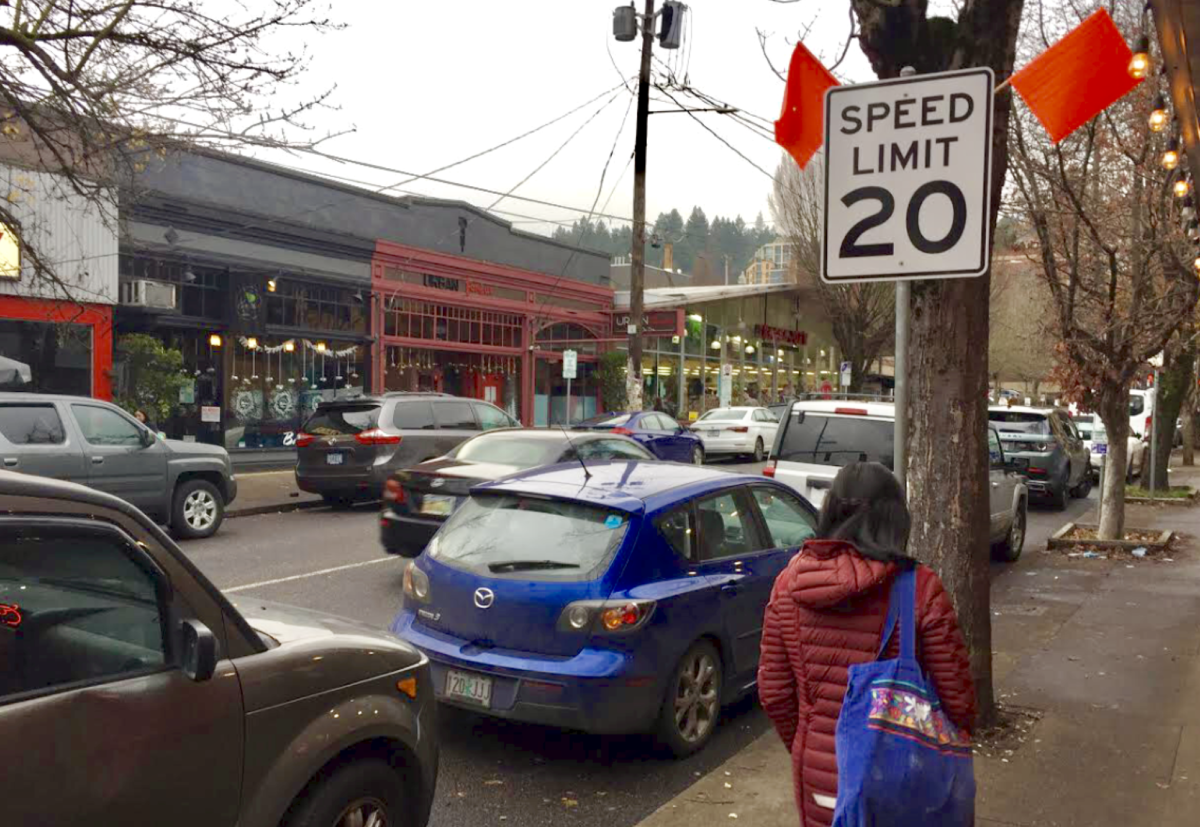
(Photo: Scott Kocher)
By Portland resident Scott Kocher, a lawyer and safety advocate who has worked tirelessly to encourage the City of Portland to lower speeds in many Northwest neighborhoods.
Have you noticed new 20 mph signs in northwest Portland?
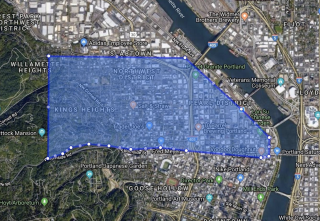
With the new signs on NW Glisan, 18th, 19th and Thurman, you’ll be hard-pressed to find a street in Northwest or the Pearl District that’s not posted 20 mph. (If you do, let me know. It’s not supposed to be there.) From NW Couch St to Upshur St, and (west of) Naito to Pittock Mansion, we now have a 20 mph Slow Zone that’s approximately 1.6 square miles. That’s not just cool, it means Northwest and the Pearl together are now possibly the largest populated area in any U.S. city with no surface streets posted faster than 20 mph. (If you know others, please let me know in the comments!) And it’s possibly the nation’s only urban area that’s all 20 mph and has homes, businesses, schools, and the other destinations that make a complete neighborhood.
If it weren’t bisected by West Burnside (25 mph), the Slow Zone would be nearly twice as big. Check out the dark grey area on this map which PBOT labeled as the “Central 20 mph zone”:
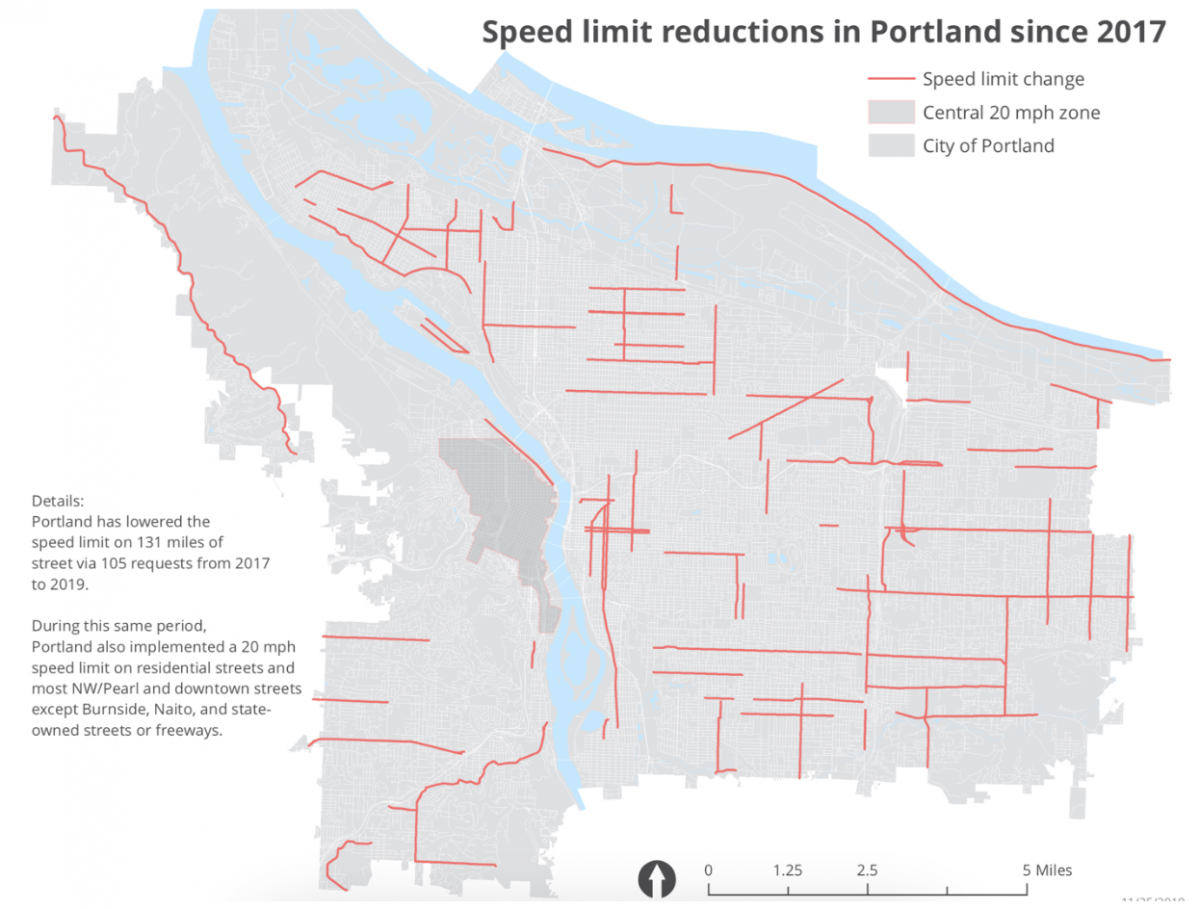
(Source: PBOT)
Advertisement
20 mph speeds not only save lives, they reduce noise and pollution from heavy acceleration and braking, and encourage people to stop at destinations rather than just blast through. Creating a complete neighborhood that is not fragmented by people driving fast is a big step, especially for elders, families with children, and anyone who doesn’t want fast traffic to be a part of their lives.
Creating a complete neighborhood that is not fragmented by people driving fast is a big step, especially for elders, families with children, and anyone who doesn’t want fast traffic to be a part of their lives.
Northwest and the Pearl are dense, and have some of the greatest potential for people to get around on foot or with mobility devices, bicycles or light electrics. To date, that potential has not been realized. Bicycling to work is less than half as popular in Northwest compared to close-in east-side neighborhoods (7% vs 14.4% respectively). The new speeds could help change that. A neighborhood greenway on Northwest Flanders will soon connect the Northwest Slow Zone with the Willamette riverfront, opening up low-stress access between Northwest and the East Side as well.
Northwest’s slow zone is the result of several factors. In 2017 the City of Portland earned a legislative victory which gave them the authority to set speeds 5 mph slower than the State of Oregon’s statutory speed on non-arterial streets in “residence districts”. Before doing so, Portland needed to pass a city ordinance directing the Portland Bureau of Transportation to implement the law. We took that step in January 2018. We got another boost with PBOT’s Northwest in Motion Plan, which included a “NW Home Zone” recommendation. That plan is in draft form and headed to City Council for adoption.
How does Portland compare to other cities?
Let’s compare Portland’s accomplishment over the past two years to two other cities battling speeders. Over the last decade New York City Department of Transportation has created 26 Slow Zones with 20 mph speeds. But, they’re mostly residential and they’re typically only about 5 x 5 blocks in size. That’s hardly a complete urban unit.
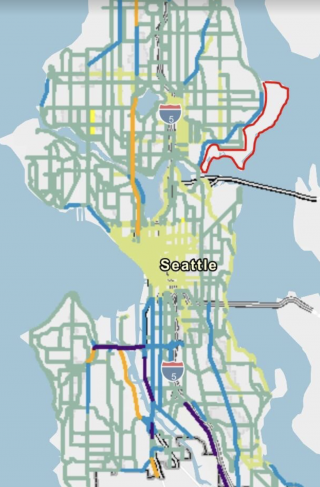
Or, compare Portland to our rival up north. Seattle adopted its 20 mph ordinance in September 2016, more than a year before Portland’s nearly identical ordinance in January 2018. The largest populated 20 mph area in Seattle appears to be a manicured residential area along the shore between the University of Washington and Magnusen Park. It is perhaps no coincidence that the areas with the lowest traffic speeds in Portland and Seattle are highly sought-after and expensive areas to live. Seattle’s slow area is roughly 1.5 square miles (less if you include park space), but it is single family homes, not a complete neighborhood with schools, employers, and other urban destinations like Northwest Portland.
Comparing Northwest Portland to Seattle’s biggest slow zone, Portland wins hands down.
Seattle’s 20 mph rollout ended up being somewhat narrower than it could have been because Seattle, inexplicably as far as I can tell, is using its own street classifications which are described here, not federal classifications to determine which streets are “non-arterial” and therefore qualify for 20 mph. Unlike the federal classifications, Seattle’s internal classification system calls major collector streets “arterial.” And, regardless of which classification system is used, Seattle has a lot of arterials.
Advertisement
Where to go from here
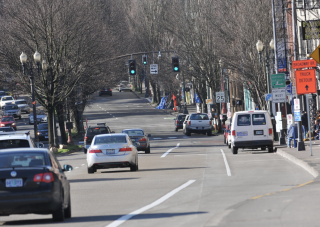
(Photo © J. Maus/ BikePortland)
The most obvious next steps would be to give the “Central 20 mph zone” a snappier name, provide calming and signal timing so that people driving are less inclined to go faster than the posted speed, and work to expand it. For starters, PBOT can — and should — ask ODOT’s Speed Zone Review Panel to rescind its order which elevates the speed on West Burnside from its statutory (default) speed of 20 mph to 25 mph. West Burnside is on PBOT’s High Crash Network. Its noise, stink and danger divide Northwest from downtown and limit the corridor’s potential for walking-oriented businesses — soon to include the long-anticipated food cart pod at Ankeny Square, where Burnside has sub-standard crossings and balloons unnecessarily from two to three lanes each direction. Taming West Burnside would unite the “Central 20 mph zone.”
Expanding family- and business-friendly slow speeds from the core outward has potentially the largest political support, and appears to be the most likely approach. However, one of the equity consequences is that outlying neighborhoods will be the last to have the same low speeds, if they ever do.
Finally, now that Portland has 20 mph signs covering 70% of its street network, it’s time to revive the defunct Traffic Calming division at PBOT. Traffic calming is more equitable and effective than enforcement to get people to drive 20 mph, and PBOT has enough money to do it.
A Toolkit For Your Own Slow Zone
If dangerous streets divide your neighborhood, simply emailing safe[at]portlandoregon.gov and asking for speed reductions can be effective. In my experience, one email can yield possibly the highest rate of return of any safety advocacy.
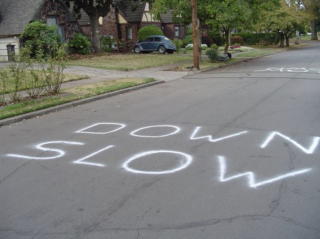
(Photo © J. Maus/BikePortland)
If you’re serious about creating a “slow zone” for your neighborhood, it can help to understand the details of speed setting. That way you’ll know whether the speeds posted on your streets are correct, and whether there is a basis to lower them.
*Wonk warning* Now is where you decide whether to dig in with me on this, or to skip to the comments below.
There are essentially six categories of streets in Portland. Depending on the category, lowering speeds may involve (1) rescission of a Speed Zone Order (SZO), (2) modification of an SZO, or (3) simply pressuring PBOT to comply with Portland’s ordinance. I’ll describe each of these processes.
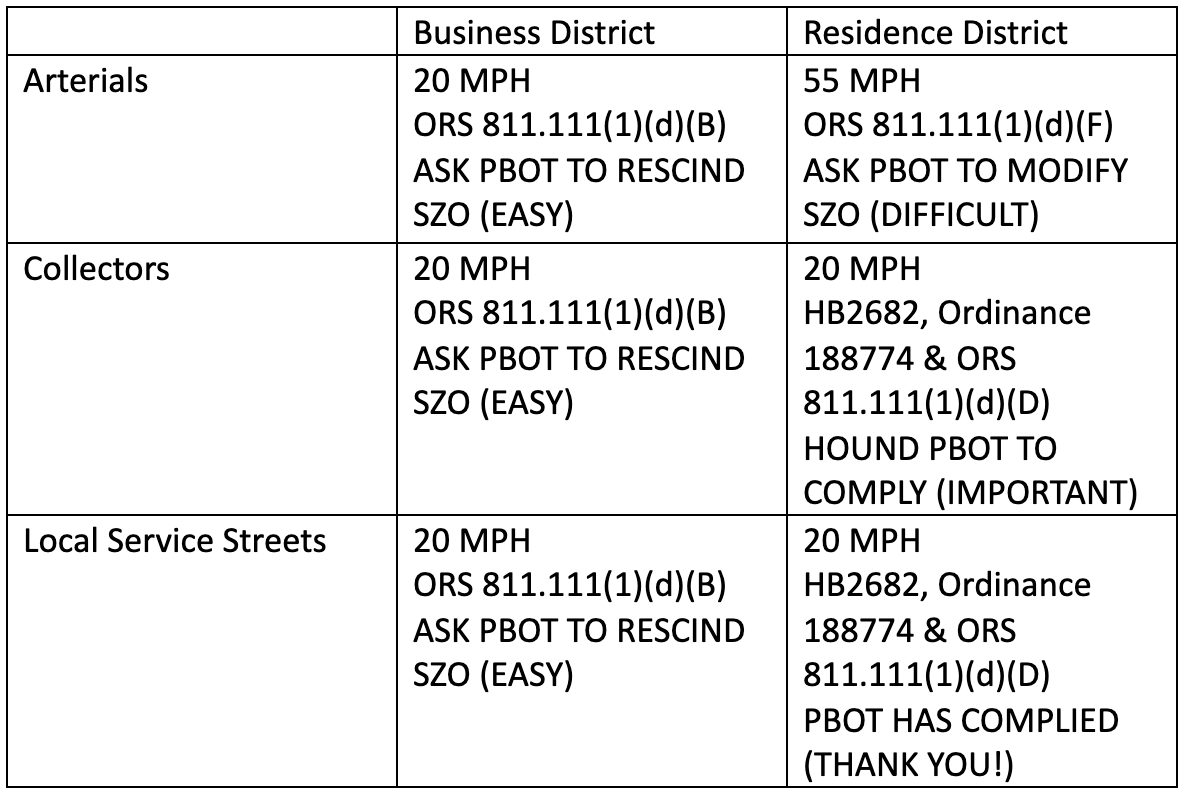
First, the chart above summarizes what I’ll describe in detail below. It shows the statutory (default) speeds with legal basis, and the advocacy process, for speed reductions on the six categories that encompass nearly all of Portland’s streets.
Advertisement
You can look up whether there is a Speed Zone Order affecting the speed on any street here. SZOs on local and collector streets in residence districts are superseded by the new 20 mph law and ordinance.
You can look up the functional classification (arterial, collector, or local service) of any street on these maps for Central Portland, East Portland, or other areas.
Don’t be put off by anyone telling you they can’t reduce the speed because the street is an emergency response route.
The first of three categories of streets to understand are streets in a business district, regardless of whether they are classified as an arterial, collector or local service street. “Business district” means at least 50% of properties are in business use. To be exact, it means 50% or more of the frontage “for a distance of 600 feet or more on one side, or 300 feet or more on both sides, is occupied by buildings used for business” (ORS 801.170). To see whether a segment of a street is in a business district, visit in person or use Google Streetview.
If you’re trying to get a street in a business district posted at 20 mph you might be in luck. The only reason it can be posted faster than 20 mph is if the state’s Speed Zone Review Panel has issued a Speed Zone Order for setting a faster speed. The statutory (default) speed for business districts regardless of the street’s classification (arterial, collector, or local service) is 20 mph. PBOT can ask for SZOs to be rescinded, causing the speed limit to default to the statutory speed. Rescission requests, unlike SZO modifications which require more effort, are easy for PBOT to do and they’re generally approved. So, what are you waiting for? Send your request to safe[at]portlandoregon.gov.
The second category is arterials in a residence district. Those are the only category for which the current speed-setting framework is less than ideal. The statutory speed is 55 mph. Fortunately, all of these that I’m aware of in Portland have SZOs setting a lower-than-statutory speed. Getting these SZOs modified to lower the speed further requires a request accompanied by an explanation from PBOT. Those requests are usually granted, but the process is more work for PBOT. Still, if you have a fast arterial running through your residence district or that of a loved one (or anyone you care about), it’s worth emailing safe[at]portlandoregon.gov.
Advertisement
The third category of streets are collectors and local service streets in residence districts. These are the streets subject to Portland’s Ordinance 188774, which “establishes by ordinance a designated speed that is five miles per hour lower than statutory speed on non-arterial streets under the jurisdiction of the City of Portland in a residence district.” Except for school zones, the statutory speed for local service and collector streets in a residence district is 25 mph.
If we want to expand and create Slow Zones in other parts of Portland, we need strong leadership at City Hall and PBOT, and your advocacy.
PBOT has posted local service streets citywide and also collector streets (a classification between local service/residential and arterial) in Northwest and the Pearl at 20 mph. That covers 70% of Portland’s street network. That’s impressive. However, PBOT has not rolled out 20 mph as directed by the ordinance on collector streets in residence districts in most of the city. If you live on or use one of these streets, you’re not getting the level of safety and comfort you’re entitled to. Join me in asking PBOT to post collectors in residence districts in your neighborhood (and citywide) at 20 mph. Don’t be put off by a spokesperson telling you the ordinance applies only to “residential streets.” That term has been used by PBOT spokespersons either as an unhelpful shorthand, or possibly to avoid addressing this issue. As the chart above reflects, “residential street” is not a term that has any legal basis. Your street is either in a residence or business district, and it’s either a local service, collector, or arterial street. Collectors in residence districts must be posted at 20 mph under the plain language of the ordinance.
Similarly, don’t be put off by anyone telling you they can’t reduce the speed because the street is an emergency response route. I’ve heard this, even a couple times from engineers who should know better. It’s simply not true. Emergency responders can use lights and sirens to go as fast as they need to go. There are plenty of examples of primary emergency response routes posted at 20 mph. There is not even a provision for the Fire Bureau to review speed limit reductions (unlike, for example, speed bumps on certain routes). As they say, in safe streets advocacy, they have to tell you “no” three times before they say “yes.”
Advertisement
Oh, and don’t forget to ask for 15 mph signs for your school zone. You can cut and paste this explanation why:
“Ordinance 188774 “establishes by ordinance a designated speed that is five miles per hour lower than statutory speed on non-arterial streets under the jurisdiction of the City of Portland in a residence district.” It is a full implementation of the City’s authority granted under ORS 810.180(11). The applicable statutory speed in school zones is 20 MPH. ORS 810.180(1)(b); ORS 811.111(1)(e). We request 15 mph for all school zones on local or collector streets in residence districts. Signs on these streets saying School Speed 20 mph should now say School Speed 15 mph.”
Is the current law working?
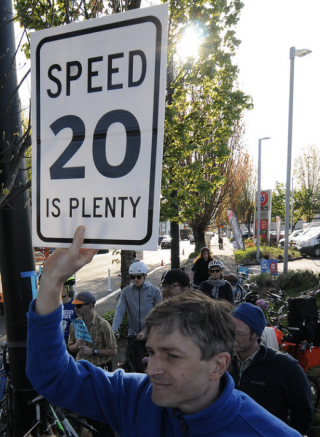
(Photo © J. Maus/BikePortland)
The current legal framework created by the Oregon Revised Statutes and the City of Portland’s ordinance does a good job providing for 20 mph speeds on five out of the six commonly-occurring types of streets in Portland. Portlanders who care about safe speeds should compare any proposals to change how speed-setting is done to the current framework. For example, the current framework reflected in the table, above, is significantly better than the framework that ODOT is proposing. Recent examples of resistance to speed reductions in Portland come from PBOT (1) declining to request rescission of SZOs (West Burnside, and SE Hawthorne west of 29th are examples); (2) not complying with Portland’s ordinance directing 20 MPH on collectors in residence districts beyond Northwest and the Pearl; and (3) not posting 15 mph for school zones. While I’m grateful for PBOT’s hard work that goes into speed reductions, the biggest advocacy hurdles to address the too-high speeds that remain on too many Portland streets reside at PBOT. The historical hurdles such as 85th percentile speed rules or ODOT bureaucracy don’t seem to be the problem.
In short, thanks to a lot of hard work at PBOT we’ve got a terrific Slow Zone taking shape in Northwest and downtown. If we want to expand it and make new Slow Zones in other parts of Portland, we need strong leadership at City Hall and PBOT, and your advocacy. I hope the details here provide a toolkit for that work, and generate interest and discussion.
Speed setting is complicated. What are your questions? Where have I got it wrong? Where can we create Portland’s next Slow Zone?
— Scott Kocher, sfkocher@gmail.com
— Get our headlines delivered to your inbox.
— Support this independent community media outlet with a one-time contribution or monthly subscription.
*DISCLAIMER: Kocher and his firm, Forum Law Group, are financial supporters of BikePortland.



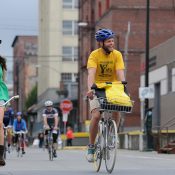
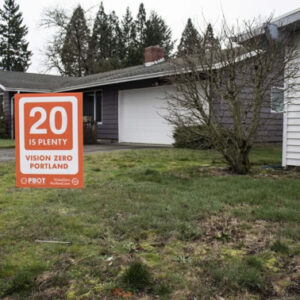
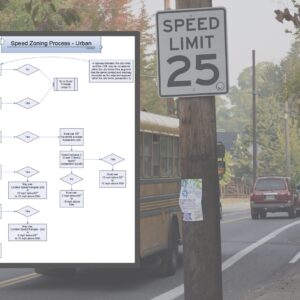
Thanks for reading.
BikePortland has served this community with independent community journalism since 2005. We rely on subscriptions from readers like you to survive. Your financial support is vital in keeping this valuable resource alive and well.
Please subscribe today to strengthen and expand our work.
The old saw around here is that paint doesn’t protect anyone, but let me tell you about signs… NW got new ones, reflecting both light and the status quo.
I don’t need signs, I need a new status quo. That’s why I wrote to SAFE.
*Months* later, it responded by saying my residential street—wider than some freeways—doesn’t qualify for any action: it’s not a school zone or other priority area. Somehow being between two major bikeways or having a school with yellow SCHOOL indicators attached to the old 20mph speed limit signs out front doesn’t qualify.
In no uncertain terms, they said neither PBOT nor PPB will even touch this unless somebody is seriously hurt. Until then I can pick up some free 20 Is Plenty yard signs downtown!
So forgive my cynicism over ineffectual signs and bureaucracies. Especially when NW gets taken care of.
Why does Bikeportland continue to push this false narrative that lower speed limits equal lower speeds?
Isn’t it a little more nuanced than that?
Doesn’t it take time for folks to become habituated to driving (a bit) slower?
Unless you can easily pass, it only takes on person driving slower to slow everyone behind him or her down.
I know! I live on an outer east Portland residential street supposedly with a 20 mph limit that is NEVER adhered to, and never even seen the police drive up my street. People are dreaming man.
Also I don’t think anyone here is asserting that a posted 20 equals 20, any more than a posted 45 equals 45. But I do suspect that when, e.g., Hawthorne got slower speed limit signs, the actual observed speed has declined. Do you know otherwise?
This is the sort of fluffy op ed piece I typically see in my local news rag, a bit of civic boosterism that I don’t typically associate with this particular hard-hitting blog.
The effect and impact of the new signage can be tested by the city laying down speed readers on the pavement, temporary metal devices covered by asphalt single, to find out before and after if the new speed limit signs are working as intended or not – and I don’t see that testing anywhere in this article.
In any city, any street in a relatively wealthy neighborhood that is relatively narrow, tree-lined and has lots of parked cars is likely going to have slower speeds anyway. And wealthier neighborhoods are generally better patrolled by city police. So learning that an already congested high-income neighborhood like Northwest Portland is getting special treatment by the city doesn’t surprise me, but from an equity standpoint it’s a huge waste of your limited city resources. It would be far better to test such a slow-speed network in Cully, Brentwood-Darlington, or Centennial, areas of high poverty and high death rates from crashes, areas where the impact will far greater and the rest of the country will actually pay attention, areas that have been pushing for such changes for years and have gotten nowhere with city hall.
I also note that Scott’s definition of Northwest Portland specifically excludes any high-speed arterial such as Burnside, Yeon, I-405, all of which would be recognized nationally as being geographically part of the area he’s writing about. Lots of cities have similar islands of wealthy tranquility surrounded by rivers and oceans of high-speed traffic – All Scott needs to do is visit other cities and he’ll find them – Hint: it’s where the wealthy live.
>>> And wealthier neighborhoods are generally better patrolled by city police. <<<
In Portland, we've come to realize that traffic enforcement is not something to strive for, but something to be driven out of our communities, and consequently, we've largely abandoned the barbaric practice of enforcing traffic rules. I hope you too will someday enjoy a similar utopia where every person and their car are unyoked from the tyranny of petty speed limits, stop signs, and traffic signals. We, the enlightened, drive as we choose, with no interference or molestation by government agents imposing arbitrary limits and meting out punishments.
We enjoy similar privileges in our local utopia here in NC, as long as we aren’t driving while being black.
actually, NW Portland has the highest % of poverty residents in the city
What’s your reasoning for thinking it doesn’t? This relatively recent study showed a reduction in the number of people exceeding specific speeds. Most notably a 29% reduction of people going over 35 mph.
https://www.iihs.org/news/detail/city-drivers-slow-down-for-lower-speed-limit-in-boston#.W4VV_MhOUNU.twitter
Everyone behind me goes 20mph when I drive through neighborhoods.
this is great, but what shame that it does not include NW Front! Nearly every cycling trip I make in NW Portland involves at least some riding on that road. When N Greeley was in the “design” phase, I attempted to get PBOT to make some safety improvements for all users. The current median speed is OVER 55 in each direction, so I encouraged them to look at design changes that would encourage slower driving (nope) or requesting a speed reduction (again, nope). In fact, they are sticking with the multiple lanes and even widening two of them. After a multiple fatality on Greeley, I asked PBOT if they would consider design mods to slow driving (crickets). And the 2-way bike route is horrible for bikes and worse for peds even though it is being called a Mixed Use Path. I really do laud these efforts, but it is very hard to not feel cynical.
I watched some mini-documentary about Ghent, Belgium, which described how the city eliminated auto traffic within the inner ring by setting up a bunch of diverters and barricades, which funnel all through auto traffic to the ring road. Local residents, tradespeople, delivery vans, etc, can get into their neighborhood, but can’t drive directly through the center section of town. If you want to move directly through it, you have to either transit, bike, scooter or walk.
I wonder if central Portland (Downtown, Goose Hollow, Pearl and NW) couldn’t do something similar. Through routes for cars would be Burnside, Glisan, Everett, Alder/Washington, Clay/Market, Naito, Vista/23rd, Broadway, 405, 26. Then you could install maybe 50 diverters that siphon cars off other streets onto the main streets. Destinations on other streets would be accessible to cars, but only as a final destination, not as a pass-through.
I think this might give us more bang for our buck more rapidly, than rolling out bike lanes piecemeal with inconsistent design standards.
Right now, regardless of what the traffic rules are, there’s little enforcement, so people basically do whatever the hell they feel like doing.
I’ve seen retractable bollards in several European cities. They can let service vehicles in but not private ones. I thought that was a nice solution.
I saw them in use in Le Mans France and in Maastricht Netherlands. Very effective. I also saw one on a minor public street in downtown Winston-Salem: certain local residents have a keycard to pass through, but not visitors (Park Vista Lane @ W. 4th Street), so there must be a way to do them in the USA.
Ghent did this because the people demanded it. If we did likewise, it could happen here too.
Chris,
you might want to check out the plan:
https://www.portlandoregon.gov/TRANSPORTATION/76131
I haven’t yet biked in NW PDX so I’ve got nothing there, buuuuttt I have recently met with my local elementary school principal and Robert Alan Ping/Trips for Kids, and what you’re saying here in the Toolkit section aligns with the advice we got from Robert. I particularly like the school zone 15 MPH ord., thank you….I’ll be printing/taking in this afternoon to principal so we can get a letter in for that…. I do traffic cones/crosswalks in the morning at the school and it’s challenging. That doesn’t even include the kids who cross Lombard w/o a light/crosswalk to get to school.
What a great idea !!!
If only we had also had a sane speed limit & enforcement here on Pill Hill. Some of the wealthily residents on the hill think that Gibbs Street has a 50 mph speed limit, and PPB doesn’t have the resources to ticket them, only to have them fight the ticket with $5,000 for their attorney. The only improvement I have been able to get from the PBOT was adding two crosswalks on Gibbs after an elderly man was hit and run. But still no enforcement…
Also I wish we could lower the speed limit to 20 mph on any street which has speed bumps, as I have already had my car road raged by a neighbor. Since a habitual drunk driver broke my back, I have to slow down for speed bumps & bad potholes, the reason one angry neighbor rear ended my car three times on two neighborhood streets…
I’ve asked, and hope to hear more about PBOT’s work to measure the effect of 20 mph signs in areas w/o other engineering changes or increased enforcement. Which is pretty much everywhere. My hunch: most drivers will continue to complain about speeding on their street and continue to drive 9 over on everyone else’s streets, because people are selfish when we’re anonymous, and drivers are accustomed to thinking they can get away with that. If so the signs will cause a modest speed reduction. Which matters bc kinetic energy increases w the square of speed, and slower means more time to perceive and avoid crashes, etc. My opinion: engineering (calming) is more effective and equitable than enforcement, and speed cameras should replace officer enforcement across the board.
factual correction:
PBOT does not create, modify, rescind, or issue Speed Zone Orders, ODOT does. Even if rescinded, PBOT retains authority to decide how to post where the law permits alternatives.
Correlation is not causation. The lower speed limits in the more expensive part of Seattle are more likely related to the power of the residents that live there, IMO.
The 20 mph sign installation is not complete. The first wave is complete, about 2,600 sign changes, including removal/replace, exchange and new installs (took about 9 months). The first wave plan is described at the end of this: https://www.portlandoregon.gov/transportation/article/669824
All future requests are on a case by case basis, and via projects, like greenways. Every new sign is a maintenance burden residents incur, so choosing where to spend limited resources, as with every roadway modification, will always be part of the equation.
As a resident of this neighborhood, I appreciate this. That said, the lighting on most corners of that entire area, especially where I live in NW 21st is so poorly lit at night, which doesn’t help.
Speaking about light… how bout some daylighting of intersections around there, eh? Some folks really push it.
Do you have any advice to share on how we could go about implementing this across the river in Vancouver, WA